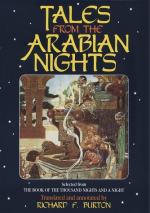of his mother, who undertakes that no harm shall befall
her during his absence. The queen is delivered
at one birth of seven lovely children, six boys and
one girl, each of whom has a silver chain around its
neck.[FN#426] The king’s mother plots with the
midwife to do away with the babes and place seven little
dogs in bed beside the poor queen. She gives the
children to one of her squires, charging him either
to slay them or cast them into the river. But
when the squire enters the forest his heart relents
and laying the infants wrapped in his mantle, on the
ground, he returns and tells his mistress that he
has done her behest. When the king returns, the
wicked Matabrun accuses his wife to him of having
had unnatural commerce with a dog, and shows him the
seven puppies. The scene which follows presents
a striking likeness to that in the Arabian story after
the birth of the third child. King Oriant is full
of wrath, and at once assembles his counsellors, “dukes,
earls knights and other lords of the realm, with the
bishop and prelate of the church,” and having
stated the case, the bishop pleads in favour of the
queen, and finally induces him not to put her to death,
but confine her in prison for the rest of her life.
Meanwhile the children are discovered by an aged hermit,
who takes them to his dwelling, baptises them and
brings them up. After some years it happens that
a yeoman in the service of the king’s mother,
while hunting in the forest, perceives the seven children
with silver chains round their necks seated under
a tree. He reports this to Matabrun, who forthwith
sends him back to kill the children and bring her
their silver chains. He finds but six of them
one being absent with the hermit, who was gone alms
seeking; and, touched by their innocent looks, he
merely takes off the silver chains, whereupon they
become transformed into pretty white swans and fly
away. How the innocence of the queen is afterwards
vindicated by her son Helyas—he who escaped
being changed into a swan—and how his brethren
and sister are restored to their proper forms would
take too long to tell, and indeed the rest of the romance
has no bearing on the Arabian tale.[FN#427]
In another mediaeval work, from which Chaucer derived
his Man of Law’s Tale, the Life of Constance,
by Nicholas Trivet, an English Dominican monk, the
saintly heroine is married to a king, in whose absence
at the wars his mother plots against her daughter-in-
law. When Constance gives birth to a son, the
old queen causes letters to be written to the king,
in which his wife is declared to be an evil spirit
in the form of a woman and that she had borne, not
a human child, but a hideous monster. The king,
in reply, commands Constance to be tended carefully
until his return. But the traitress contrives
by means of letters forged in the king’s name
to have Constance and her son sent to sea in a ship,
where she meets with strange adventures. Needless
to say, the old queen’s wicked devices come
to naught.




